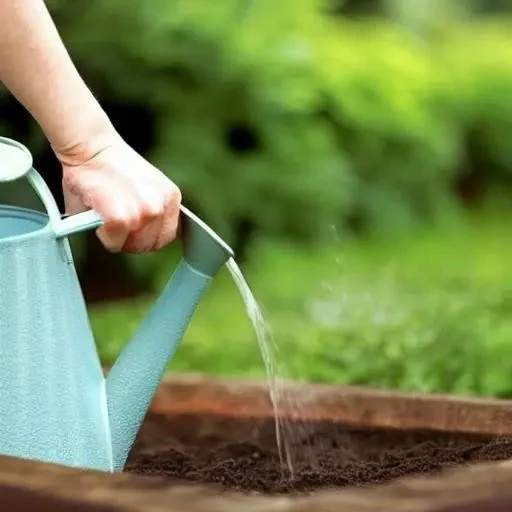There’s an undeniable magic in watching a new flower garden burst into life‚ its vibrant hues promising a season of beauty and delight. Yet‚ for many aspiring green thumbs‚ the crucial first weeks can feel like navigating a botanical minefield‚ particularly when it comes to irrigation. The omnipresent question — “how often should I be watering my new flower garden?”, often confounds even seasoned enthusiasts‚ leading to both overwatering woes and parched plant despair. But what if the answer wasn’t a rigid schedule‚ but rather a dynamic conversation between you‚ your soil‚ and your budding blooms?
Indeed‚ cultivating a flourishing new garden transcends a simple ‘set it and forget it’ approach to water. It demands a nuanced understanding of environmental factors‚ plant physiology‚ and even the subtle whispers of your emerging flora. As of today‚ September 22‚ 2025‚ horticultural experts emphasize that successful establishment hinges on consistent‚ thoughtful hydration‚ particularly during those delicate initial weeks. By adopting an informed strategy‚ you’re not just pouring water; you’re investing in a robust root system‚ resilient growth‚ and an ultimately breathtaking display that will be the envy of your neighborhood.
Below is a summary of key considerations for ensuring your new flower garden receives the perfect amount of hydration:
| Factor | Description | Recommendation for New Flower Gardens |
|---|---|---|
| Plant Stage | The developmental phase of your flowers‚ from seed to established plant. |
|
| Soil Type | The composition and drainage characteristics of your garden soil. |
|
| Climate & Weather | Ambient temperature‚ humidity‚ wind‚ and recent rainfall. |
|
| Watering Technique | How water is applied to the garden. |
|
| General Rule of Thumb | A baseline measurement for overall garden hydration. | Aim for approximately 1 inch of water per week‚ including rainfall‚ once plants are past the initial daily/every-other-day establishment phase. |
Reference: Gardening Know How
The journey from a bare patch of earth to a vibrant floral tapestry is remarkably rewarding‚ but it’s a process punctuated by critical moments of care. One of the most common pitfalls for new gardeners is the ‘one-size-fits-all’ watering mentality. As renowned florist David Denyer from Eflorist wisely observes‚ “Watering depends on where you are and what you’re growing; it depends on the weather‚ the soil‚ the plant‚ and its stage of maturity.” This isn’t just a casual observation; it’s a profound truth underscoring the dynamic nature of successful horticulture. Understanding this variability empowers you to move beyond guesswork‚ fostering an environment where your ‘newbies’ don’t just survive‚ but truly thrive.
Initially‚ during the foundational first two weeks‚ your nascent plants are like delicate infants‚ requiring constant attention. Newly planted seeds and seedlings‚ with their tender root systems just beginning to explore the soil‚ may indeed demand daily hydration. This constant moisture fosters root establishment‚ a critical phase that dictates future plant health and vigor. However‚ this isn’t about drenching; it’s about maintaining consistent‚ even soil moisture. By integrating insights from careful observation‚ you’ll intuitively learn to distinguish between a parched patch and a sufficiently hydrated bed‚ ensuring that every drop counts towards robust growth.
As your flowers mature‚ the watering rhythm gracefully shifts. The general guideline of approximately one inch of water per week – a measurement that includes any natural rainfall – becomes your guiding star. This isn’t a superficial sprinkle; it’s a deep‚ deliberate soak‚ penetrating the soil to encourage roots to stretch downwards‚ forging a resilient foundation against future dry spells. Imagine your garden as a living sponge; a deep‚ infrequent watering is like fully saturating it‚ allowing it to slowly release moisture over time‚ rather than merely dampening the surface. This deep irrigation is particularly vital for newly installed shrubs and trees‚ which‚ while more established than annuals‚ still require substantial water to anchor themselves firmly.
Crucially‚ the time of day you choose to water can dramatically impact efficiency and plant health. Experienced gardeners universally advocate for morning watering‚ ideally between 6 and 10 AM. This timing allows the plants ample opportunity to absorb the moisture before the midday sun intensifies‚ minimizing evaporative losses. Furthermore‚ watering in the morning ensures that foliage has sufficient time to dry‚ a simple yet incredibly effective strategy for deterring the development and spread of fungal diseases that thrive in prolonged damp conditions. It’s a preventative measure‚ akin to an early morning health boost for your entire garden ecosystem.
Ultimately‚ the most sophisticated watering system available is your own keen observation. The plants themselves are your most articulate teachers‚ communicating their needs through subtle cues. Feeling the soil is paramount: if it feels dry two inches down‚ it’s likely time to water. Consider your soil type carefully; sandy soils‚ for instance‚ demand more frequent‚ lighter applications because they drain rapidly‚ whereas heavier clay soils retain moisture longer‚ necessitating less frequent but more voluminous watering. This intimate connection with your garden‚ fostered by diligent attention and informed decision-making‚ transforms a routine chore into a deeply satisfying act of cultivation.
Looking ahead‚ embracing these intelligent watering practices will undoubtedly lead to a more vibrant‚ resilient‚ and stunning flower garden. It’s an optimistic vision for every aspiring horticulturist‚ promising not just survival for your new plants‚ but a future filled with abundant blooms and the profound joy of a flourishing green space. By diligently applying these principles‚ you are not merely nurturing flowers; you are cultivating a masterpiece‚ one perfectly hydrated root at a time‚ ensuring that your garden becomes a testament to thoughtful care and bountiful natural beauty.






